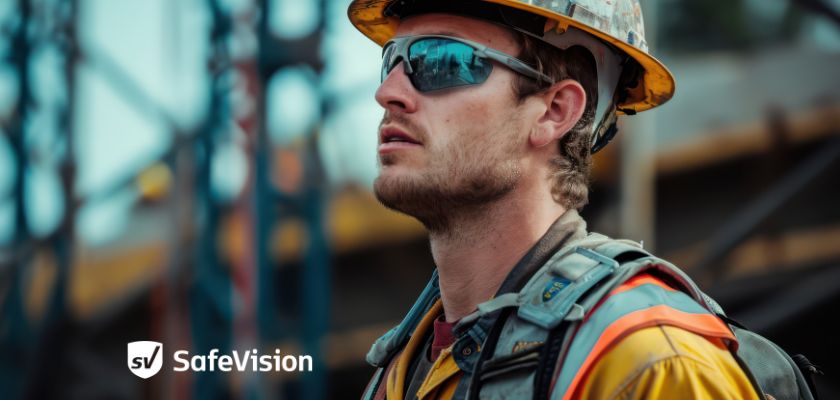Safety, Safety Glasses
Prescription Safety Eyewear For Manufacturing Industries
Manufacturing environments expose workers to a wide range of eye hazards—from flying debris and chemical splashes to dust, sparks, and intense light. According to Prevent Blindness, more than 2,000 work-related eye injuries occur in the U.S. every day, with 10–20% resulting in temporary or permanent vision loss. Moreover, experts estimate that 90% of these injuries could be prevented with proper eye protection . Prescription safety eyewear is a key part of that prevention strategy.
For employees who require vision correction, prescription safety eyewear offers the necessary protection while maintaining clear vision and meeting OSHA and ANSI standards.
WHY PRESCRIPTION SAFETY EYEWEAR IS ESSENTIAL IN MANUFACTURING
Manufacturing plants typically involve fast-paced workflows and heavy machinery. Visual clarity is essential for tasks such as precision measuring, cutting, welding, quality inspection, and equipment operation.
Workers who rely on standard dress eyewear or attempt to fit safety goggles over regular prescription glasses often struggle with discomfort, fogging, or distorted vision—conditions that can lead to decreased productivity and an increased risk of accidents.
Prescription safety eyewear solves these problems by combining visual acuity with the impact protection required on the shop floor.
COMMON EYE HAZARDS IN MANUFACTURING SETTINGS
Some of the most frequent eye hazards encountered in manufacturing include:
- Flying debris or particles (metal, wood, plastic, glass)
- Chemical splashes or fumes
- Dust or fine particulate matter
- Intense light or heat from welding, grinding, or cutting tools
- Airborne contaminants from machining or finishing processes
Each of these hazards requires a specific type of protection. Prescription safety glasses with ANSI Z87.1-certified lenses and frames ensure that workers have the necessary defense against these common threats.
MEETING ANSI Z87.1 AND OSHA STANDARDS
Prescription safety glasses used in manufacturing must comply with ANSI Z87.1 standards, which govern impact resistance, lens retention, optical clarity, and frame integrity. These glasses are marked accordingly to ensure easy identification.
Under OSHA 29 CFR 1910.133, employers are required to provide eye and face protection that meets ANSI standards when employees are exposed to eye hazards.
Key compliance elements include:
- Frames marked with “Z87-2+” for high-impact protection
- Lenses made from polycarbonate or Trivex, both of which meet or exceed ANSI impact requirements
- Integrated or permanently attached side shields for full lateral coverage
BENEFITS OF PRESCRIPTION SAFETY EYEWEAR FOR MANUFACTURING WORKERS
Aside from protecting workers from injury, prescription safety eyewear offers other practical benefits:
Improved visual performance
Clear, prescription-corrected vision helps reduce fatigue and increases precision during detailed work.
Comfort and convenience
Eliminates the need to wear uncomfortable goggles over regular glasses.
Better compliance
Workers are more likely to wear safety glasses that fit properly and allow them to see clearly.
Custom options
Lenses can be customized with anti-fog coatings, light-reactive tinting, or polarization depending on lighting and environmental conditions.
RECOMMENDED LENS MATERIALS FOR MANUFACTURING ENVIRONMENTS
When selecting prescription lenses for industrial environments, polycarbonate and Trivex are the materials of choice due to their high impact resistance and lightweight nature. These materials also offer:
- 100% UV protection
- High optical clarity
- Scratch resistance with optional coatings
- Compatibility with a wide range of frame styles and designs
Trivex, in particular, offers a higher Abbe value than polycarbonate, resulting in better peripheral clarity for certain users.
WRAPAROUND VS. TRADITIONAL SAFETY FRAMES
In manufacturing settings where dust, flying particles, or liquid splashes are common, wraparound frames offer additional protection by contouring to the face and reducing gaps. These are ideal for:
- CNC operators
- Metal or wood fabricators
- Workers exposed to spray coatings or airborne particles
For jobs that require frequent switching between visual tasks or prolonged wear, traditional safety frames with adjustable features and removable side shields may be a better option for comfort and versatility.
HOW SAFEVISION SUPPORTS MANUFACTURING WORKFORCES
At SafeVision, we specialize in prescription safety eyewear programs tailored to the needs of industrial and manufacturing environments. We offer:
- A wide selection of ANSI-compliant frames
- Lenses made only from polycarbonate and Trivex materials
- Optional anti-fog, anti-scratch, and UV coatings
- Assistance with corporate safety eyewear programs, including streamlined billing and employee ordering portals
Whether you’re outfitting a small fabrication shop or a large-scale manufacturing facility, our solutions are built to meet safety standards while keeping your workforce productive and protected.
Providing your team with properly fitted, ANSI-rated prescription safety glasses is a proactive investment in workplace safety. It not only helps prevent injury but also improves performance and morale.
Ensuring every worker can see clearly and safely is a simple but critical step toward maintaining a safe and efficient manufacturing operation.

